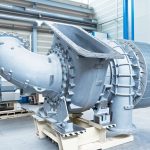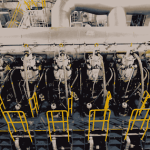A scavenge fire can occur when the accumulated oil in the scavenge spaces are ignited by blow past from the combustion space. The oil within the scavenge space is present due to the drainage from the piston ring area, and should flow out of the engine under constant “blow down” into a drain tank. Normally no blow past should be present, but when excess liner and ring wear is present this could occur.
Scavenge fires can cause distortion of the diaphragm sealing the scavenge space from the crankcase, as well as failure of sealing rings in that area. In addition the high temperatures can lead to a crankcase explosion, as oil droplets are evaporated within the crankcase.
Action on Scavenge Fire
In the event of a scavenge fire occurring:
1. Contact the Bridge and request to slow down immediately and stop engine as soon as possible
2. Contact Chief Engineer
3. Stop engine, and shut off the fuel supply to the engine
4. Stop the auxiliary blowers
5. Operate the steam or CO2 extinguishing medium on the affected cylinders
6. Engage and operate turning gear with pre lubrication.
In the event of the scavenge fire occurring and that the main engine cannot be stopped, then the following course of action would be taken:
1. Contact the Bridge and request to slow down to the lowest power possible
2. Increase the cylinder lube oil feed rate to the affected cylinder
3. Lift the fuel pump on the affected cylinder, using the manual activation of the air cylinder (option fitted for fuel pipe leakage system).
4. Prepare the fire fighting equipment to tackle any fire that may be emitted from the scavenge receiver relief valve.
5. Move all personnel away from the engine, should the scavenge fire burn long enough to trigger a crankcase explosion.
6. The scavenge fire should burn out, once all the oil is consumed.
7. Stop the engine as soon as possible, to allow the fire (if still burning to be extinguished) and the affected areas within the engine to be inspected.


